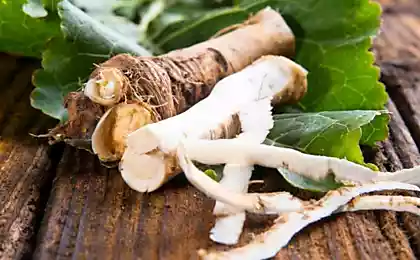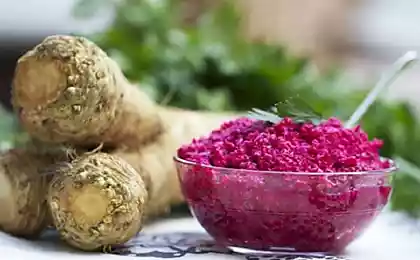328
Katran — a substitute for horseradish, but less aggressive and decorative
We will focus on the spiny dogfish is a herbaceous perennial belonging to the family Cruciferae. This plant is wholesome, delicious, and even looks interesting. It would be appropriate in the garden and in the flower bed, and even in rockeries. In Russia grow in the wild, about 20 species of spiny dogfish, but selling the seeds are only 2 varieties (Piedra and chord).

Where the use of Katran In food can be used as the underground portion of the spiny dogfish, and overhead (young leaves with petioles). The roots taste like horseradish, but more juicy and useful (richer by its chemical composition). They boiled, baked, added to salads and vegetables for canning. A spice made from the crushed roots of Katran is as sharp and odorous as hell. Young leaves with petioles can be boiled and then roll in breading mixture and fry in oil.
With the medical purpose Katran used too. It stimulates the bowels, improves appetite, can be used as an additional tool in the treatment of gums. A decoction of the rhizomes of Katran is a good General tonic.
Description of the plant the Root system of Katran rod. The roots can reach a weight of 0,5 kg or more at a length of about 0.5 m and diameter at top 7 cm of Branches almost there, which greatly facilitates its cleaning. The leaves are very large (in length up to 0.9 m and 0.3 m in width), long-petiolate, bluish-green, with wavy edges.
In the first year, the stalks are not formed, the following year, they are not all plants. The flowers are small, white, 4-petaled, very fragrant. Depending on the kind of the height of the stalks is in the range of 0.6-1.4 m. Blooms Katran in may, attracting numerous insects. Larger roots grow netsvetuschie copies. The fruit of the plant is a pod containing one seed. The seeds when ripe fall off easily.
Katran heat-resistant and cold-resistant. In the winter the leaves die, the Central root is reduced and deepened in the ground about 4 cm So the plants have no problem to spend the winter without shelter, not vimarsa even in severe winters. Katran to grow from seed or from root cuttings.
How to grow Katran in their area of Katran unpretentious, can grow in almost any soil, except waterlogged and strongly acidic. Breathable on the fertile soils the roots grow larger. Very picky about the lighting, the shading carries a bad thing, especially at a young age. It is undesirable to plant after members of this family (cabbage, radish, etc.), because the defeat of Clubroot.

Growing from seed for germinating Seeds need stratification, so sow them makes sense for the winter, better in September and October. To germinate in the spring they'll start early, 5 °C they have enough, seedlings can withstand cold of up to — 5 °C.
When spring sowing seeds need 2-month storage in the refrigerator. The quality of the soil it is desirable to use a moist sand. The passage of time a container sowing should be moved to a bright window sill. It happens that the shoots begin to appear in the fridge. For plant growth the optimum temperature is at 21 °C.
Seedlings are transplanted at the age of just over 40 days in a permanent place, this time on the plants, as a rule, formed of 4-5 leaves. The optimal distance in row 40 cm spacing 60 cm In the first year developed plants are not very active, forming only a rosette of leaves. The following year, the greenery starts to grow very early, the growth rate increases significantly.
The cultivation of root cuttings For propagation of Katran root cuttings used lateral roots (up to 15 cm), cut from the roots at autumn harvest. They share several pieces, stored until spring at a temperature of about 0 °C. it is Important to note the lower and upper parts so as not to make a mistake when planting (you can lower the slice to make oblique, and the upper level). When a thawed soil with the cuttings need to remove the excess buds, leaving only the top. To plant the cuttings in the prepared place preferably sloping, densely objav soil.
Care and harvest Care Katran is easy. In the initial period of growth, young plants need watering, weeding, thinning, if necessary, and loosening the soil between rows. The number of feedings depends on the fitness and nutrition of the soil.
In the first year the root is a small (about 200-250 g), if it does not touch (although in principle possible), then the weight will increase significantly. When planting root cuttings of marketable roots reach 6 months. Katran removed at the beginning of October, undermining the forks. The roots immediately placed in containers with moist sand and place them in the basement. Optimum storage temperature is 4 °C with sufficient humidity (85%). published
P. S. And remember, only by changing their consumption — together we change the world! © Join us at Facebook , Vkontakte, Odnoklassniki
Source: 101dizain.ru

Where the use of Katran In food can be used as the underground portion of the spiny dogfish, and overhead (young leaves with petioles). The roots taste like horseradish, but more juicy and useful (richer by its chemical composition). They boiled, baked, added to salads and vegetables for canning. A spice made from the crushed roots of Katran is as sharp and odorous as hell. Young leaves with petioles can be boiled and then roll in breading mixture and fry in oil.
With the medical purpose Katran used too. It stimulates the bowels, improves appetite, can be used as an additional tool in the treatment of gums. A decoction of the rhizomes of Katran is a good General tonic.
Description of the plant the Root system of Katran rod. The roots can reach a weight of 0,5 kg or more at a length of about 0.5 m and diameter at top 7 cm of Branches almost there, which greatly facilitates its cleaning. The leaves are very large (in length up to 0.9 m and 0.3 m in width), long-petiolate, bluish-green, with wavy edges.
In the first year, the stalks are not formed, the following year, they are not all plants. The flowers are small, white, 4-petaled, very fragrant. Depending on the kind of the height of the stalks is in the range of 0.6-1.4 m. Blooms Katran in may, attracting numerous insects. Larger roots grow netsvetuschie copies. The fruit of the plant is a pod containing one seed. The seeds when ripe fall off easily.
Katran heat-resistant and cold-resistant. In the winter the leaves die, the Central root is reduced and deepened in the ground about 4 cm So the plants have no problem to spend the winter without shelter, not vimarsa even in severe winters. Katran to grow from seed or from root cuttings.
How to grow Katran in their area of Katran unpretentious, can grow in almost any soil, except waterlogged and strongly acidic. Breathable on the fertile soils the roots grow larger. Very picky about the lighting, the shading carries a bad thing, especially at a young age. It is undesirable to plant after members of this family (cabbage, radish, etc.), because the defeat of Clubroot.

Growing from seed for germinating Seeds need stratification, so sow them makes sense for the winter, better in September and October. To germinate in the spring they'll start early, 5 °C they have enough, seedlings can withstand cold of up to — 5 °C.
When spring sowing seeds need 2-month storage in the refrigerator. The quality of the soil it is desirable to use a moist sand. The passage of time a container sowing should be moved to a bright window sill. It happens that the shoots begin to appear in the fridge. For plant growth the optimum temperature is at 21 °C.
Seedlings are transplanted at the age of just over 40 days in a permanent place, this time on the plants, as a rule, formed of 4-5 leaves. The optimal distance in row 40 cm spacing 60 cm In the first year developed plants are not very active, forming only a rosette of leaves. The following year, the greenery starts to grow very early, the growth rate increases significantly.
The cultivation of root cuttings For propagation of Katran root cuttings used lateral roots (up to 15 cm), cut from the roots at autumn harvest. They share several pieces, stored until spring at a temperature of about 0 °C. it is Important to note the lower and upper parts so as not to make a mistake when planting (you can lower the slice to make oblique, and the upper level). When a thawed soil with the cuttings need to remove the excess buds, leaving only the top. To plant the cuttings in the prepared place preferably sloping, densely objav soil.
Care and harvest Care Katran is easy. In the initial period of growth, young plants need watering, weeding, thinning, if necessary, and loosening the soil between rows. The number of feedings depends on the fitness and nutrition of the soil.
In the first year the root is a small (about 200-250 g), if it does not touch (although in principle possible), then the weight will increase significantly. When planting root cuttings of marketable roots reach 6 months. Katran removed at the beginning of October, undermining the forks. The roots immediately placed in containers with moist sand and place them in the basement. Optimum storage temperature is 4 °C with sufficient humidity (85%). published
P. S. And remember, only by changing their consumption — together we change the world! © Join us at Facebook , Vkontakte, Odnoklassniki
Source: 101dizain.ru
One glass of this drink before sleep and You will get rid of excess weight!
Natural popularity of solid-fuel boilers?























